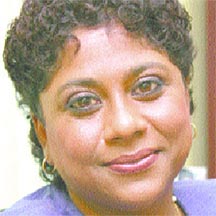By Vaneisa Baksh
(Trinidad Express) Perhaps the biggest failing of the ongoing Caribbean Premier League cricket tournament is the quality of radio commentary.

For a Caribbean that has had a long relationship with voices coming across the airwaves to inform them of cricket matters, it is disturbing to hear what has come to pass as commentary and coverage.
While we still hear the echoes of Tony Cozier and Joseph “Reds” Pereira ringing in our ears, it is an assault to have to contend with the jokers who have been let loose among the microphones.
I know the CPL is designed to make money, and I know the top line is really the bottom line, so “rights” are sold to everything conceivable. But in the hasty quest for immediate cash, we are killing standards that had been a source of West Indian pride, and it will come back to haunt us as it has done in the print media.
Two decades ago, media house owners, excited by technology that allowed for newspaper pages to be designed on-screen, decided it would be much cheaper to do away with the function known as sub-editing (a combination of proof-reading, fact-checking, headline-writing and page design), and instead have all pages “done” by people whose skill was mainly in using graphic design programmes. This new person was called a paginator, and the category replaced the focus from content to layout and speed. It has led to many seepages in the quality of newspapers.
Radio has long lost its self-respect and its standards seem to be set at vying for who could outdo the other for malapropisms, crassness, shouting and ignorance. But even as radio was degenerating, cricket commentary had managed to retain its niche as a space where one could hear intelligence, wit, history and evocative language.
What I have heard on the radio during this CPL tournament means even this sacred art has fallen down into the gutters that abound on the perimeters of rum shops. To be fair, it did not fall down during the tournament, but it is most grating and emphatic because of the absence of exemplary voices like Cozier’s and Reds’.
The current team treats radio commentary as idle chatter among “the boys”, freely trading jokes about each other’s looks, tastes, dress sense, night- and daytime activities, and their preferences for freebies, food and women. Sexism flows so thoughtlessly that you know even if you tried to draw it to their attention, they wouldn’t understand what you were talking about. The most senior of them seems to spend all his time on air inappropriately advertising for different sponsors. Amid all their annoying giggling, the whole thing is obscene. And to top everything off, they offer the most banal descriptions of the cricket; everything is a cliché, every other word is mispronounced; analysis is barely there, and then it is almost always as insular as a cricket board’s. While television commentary has generally been a far cry from this, it is not without its share. Many complain about the use of former cricketers, and while some really are good, others like our former T&T captain need to join the radio commentators for some training, especially in grammar and diction.
This is not simply about knocking them; every profession requires training, and they should respect that, especially as they get paid. Broadcasting is no exception. As they now say all over the world: what do they know of cricket who only cricket know?
When these men jabber away like that about our cricket, it reduces everything. They make the idea of a cricket match—Test or T20—seem so small and insignificant that it is hard to remember its magnificence.




